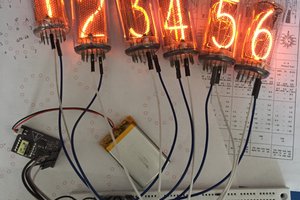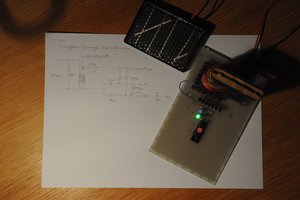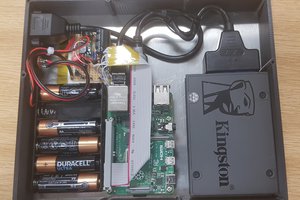Since most SoHo networking gear these days are powered by DC wall warts, we don't have to design a switch for AC. It's enough to just put a P MOSFET in the positive DC rail (that MOSFET needs to be kinda beefy is all). The MOSFET has a pull-down (we want the power to default to ON, after all) on the gate and a second P MOSFET is set up to pull the first MOSFET's gate up to turn the power off. This second MOSFET is necessary because the first MOSFET's gate must be pulled up to the input voltage rail, and the thing doing the pulling is running at a lower voltage than that. The second P MOSFET's gate is pulled up rather than down, so that it defaults to off (remember, turning that MOSFET on means turning the main power off).
The gate of the 2nd P MOSFET is pulled-up to the input rail and connected up to a third MOSFET, this time an N channel one whose gate is pulled down and connected to a microcontroller pin.
One issue with powering the circuit at higher DC voltages is that we must not exceed the maximum gate voltage of the two P MOSFETs. The usual mechanism for doing this is to add a zener diode between the gate and positive rail. For the second P MOSFET, whose gate is pulled to ground by the N MOSFET, we also need to add a current limiting resistor to protect the zener diode. However, it is possible to do without the zener diodes if you insure that the maximum Vgs of the two P MOSFETs exceeds the working voltage for the equipment you're controlling. Since most SOHO routers have a 12 volt supply, that's not hard. I chose DMP3099 transistors because they have a 20 volt Vgs, 30 volt Vds and maximum Id of over 3 amps.
This rather Rube Goldberg transistor arrangement allows us to use a low powered microcontroller to turn the output power off briefly, but with everything defaulting to the "on" state (in case something goes wrong). Imagine, for example, if the microcontroller failed to start. If we required an asserted output to turn the power on, then this failure would result in the power being off permanently. The microcontroller failing by shorting an output to Vcc is much, much less likely.
The microcontroller is a simple ATTiny9. In addition to the output pin, there is an input pin that comes from the outside. There's a protection diode on the input that prevents any voltage fed into that pin from arriving at the controller. The pin is defined as an open-drain input. You short that pin to ground to request a power-cycle.
You wouldn't necessarily think that a controller would be required for this, except that we want the controller to have some rules to act as a fail-safe for the system. It has software de-bouncing in place, so that the input has to go low and stay low for a full second before the power is cycled. The power is cycled for 10 seconds, and then the input has to go high and stay high for an hour before any low transition is allowed.
The microcontroller is powered from an LDO fed by the input power rail. It's consumption is so low (less than 1 mA) that we can use a SOT23-5 unit and still be unconcerned about it's power dissipation over it's entire input voltage range.
 Nick Sayer
Nick Sayer




 Bud Bennett
Bud Bennett
 Paul Andrews
Paul Andrews
 Matthias Koch
Matthias Koch
what about OpenWrt?